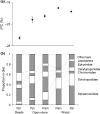Spatial subsidies in spider diets vary with shoreline structure: Complementary evidence from molecular diet analysis and stable isotopes
- PMID: 28031795
- PMCID: PMC5167037
- DOI: 10.1002/ece3.2536
Spatial subsidies in spider diets vary with shoreline structure: Complementary evidence from molecular diet analysis and stable isotopes
Abstract
Inflow of matter and organisms may strongly affect the local density and diversity of organisms. This effect is particularly evident on shores where organisms with aquatic larval stages enter the terrestrial food web. The identities of such trophic links are not easily estimated as spiders, a dominant group of shoreline predator, have external digestion. We compared trophic links and the prey diversity of spiders on different shore types along the Baltic Sea: on open shores and on shores with a reed belt bordering the water. A priori, we hypothesized that the physical structure of the shoreline reduces the flow between ecosystem and the subsidies across the sea-land interface. To circumvent the lack of morphologically detectable remains of spider prey, we used a combination of stable isotope and molecular gut content analyses. The two tools used for diet analysis revealed complementary information on spider diets. The stable isotope analysis indicated that spiders on open shores had a marine signal of carbon isotopes, while spiders on reedy shores had a terrestrial signal. The molecular analysis revealed a diverse array of dipteran and lepidopteran prey, where spiders on open and reedy shores shared a similar diet with a comparable proportion of chironomids, the larvae of which live in the marine system. Comparing the methods suggests that differences in isotope composition of the two spider groups occurred because of differences in the chironomid diets: as larvae, chironomids of reedy shores likely fed on terrestrial detritus and acquired a terrestrial isotope signature, while chironomids of open shores utilized an algal diet and acquired a marine isotope signature. Our results illustrate how different methods of diet reconstruction may shed light on complementary aspects of nutrient transfer. Overall, they reveal that reed belts can reduce connectivity between habitats, but also function as a source of food for predators.
Keywords: Baltic Sea; DNA barcoding; Pardosa; chironomids; stable isotope analysis.
Figures

 = open shores,
= open shores,  = reedy shores). Satellite imagery © 2012 DigitalGlobe, imagery date: 13/12/2015, Google Earth
= reedy shores). Satellite imagery © 2012 DigitalGlobe, imagery date: 13/12/2015, Google Earth

References
-
- Anderson, W. B. , Wait, D. A. , & Stapp, P. (2008). Resources from another place and time: Responses to pulses in a spatially subsidized system. Ecology, 89, 660–670. - PubMed
-
- Bartels, P. , Cucherousset, J. , Steger, K. , Eklov, P. , Tranvik, L. J. , & Hillebrand, H. (2012). Reciprocal subsidies between freshwater and terrestrial ecosystems structure consumer resource dynamics. Ecology, 93, 1173–1182. - PubMed
-
- Belivanov, Y. K. , & Hambäck, P. A. (2015). The time scale of isotope signals in spiders: Molting the remains of a previous diet. Entomologia Experimentalis et Applicata, 156, 271–278.
-
- Bernays, E. A. (2001). Neural limitation in phytophagous insects: Implications for diet breadth and evolution of host affiliation. Annual Review of Entomology, 46, 703–727. - PubMed
-
- Birkhofer, K. , Wise, D. H. , & Scheu, S. (2008). Subsidy from the detrital food web, but not microhabitat complexity, affects the role of generalist predators in an aboveground herbivore food web. Oikos, 117, 494–500.
LinkOut - more resources
Full Text Sources
Other Literature Sources

